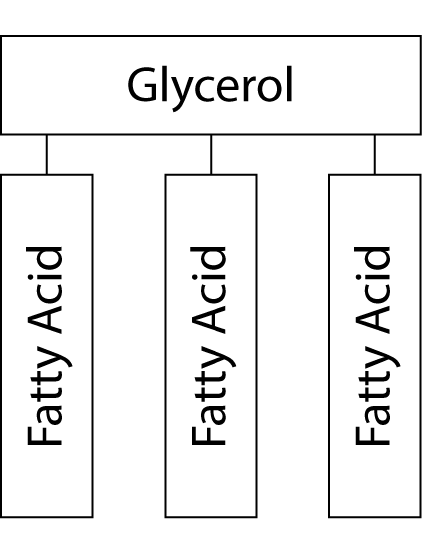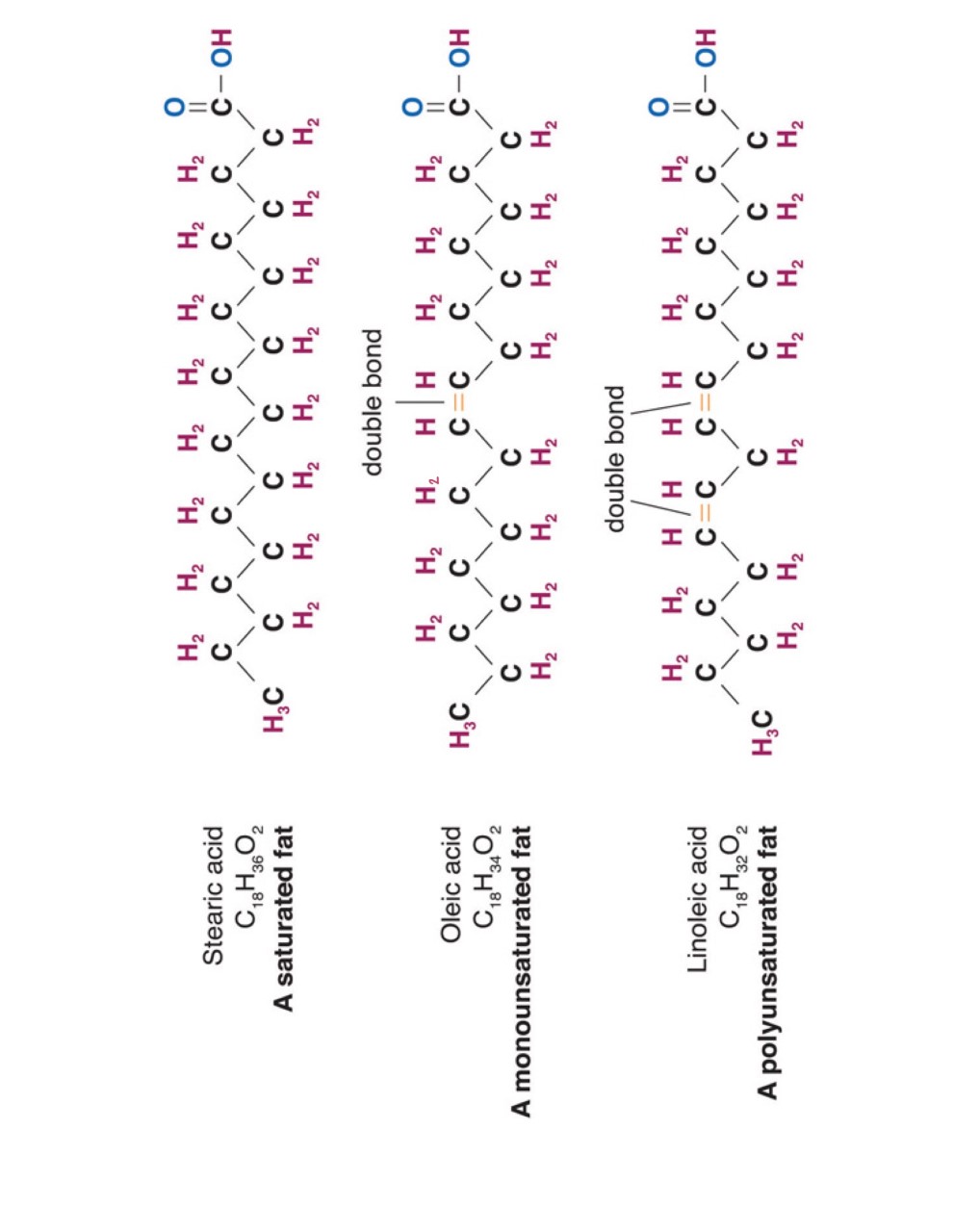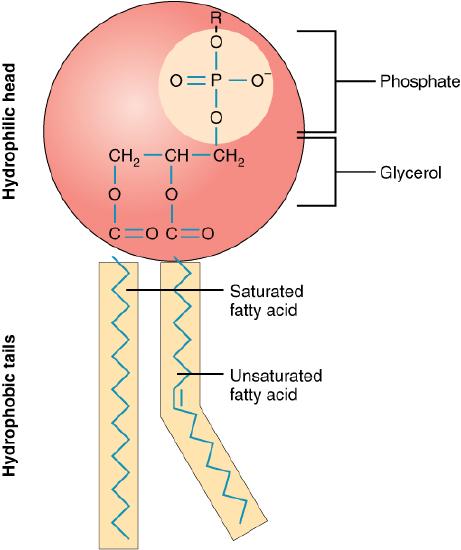5.1: Introduction to Lipids
- Page ID
- 21122
Learning Objectives
- Describe the three types of lipids.
- Compare and contrast the structure of the following types of fats:
- triacylglycerols (including saturated, monounsaturated, polyunsaturated, cis, trans, omega-3, and omega-6 fatty acids)
- phospholipids
- sterols
Does it surprise you to know that you should not eat a fat-free diet? Lipids are essential nutrients and we need these compounds in the diet in moderate amounts. Lipids are a family of organic compounds that are mostly insoluble in water. Composed of fats and oils, lipids are molecules that yield high energy and have a chemical composition mainly of carbon, hydrogen, and oxygen. The three main types of lipids are triacylglycerols, phospholipids, and sterols (Figure \(\PageIndex{1}\)).

Triacylglycerols
Triacylglycerols (also known as triglycerides) make up more than 95 percent of lipids in the diet and are commonly found in fried foods, vegetable oil, butter, whole milk, cheese, cream cheese, and some meats. Naturally occurring triacylglycerols are found in many foods, including avocados, olives, corn, and nuts. We commonly call the triacylglycerols in our food “fats” and “oils.” Lipids have two main forms - fats, which are solid at room temperature, and oils, which are generally liquid at room temperature. As with most fats, triacylglycerols do not dissolve in water. The terms fats, oils, and triacylglycerols are often used interchangeably. In this chapter when we use the word fat, we are referring to triacylglycerols.
Triacylglycerols (triglycerides) are the most common type of fat eaten and stored in the body. The types of fatty acids in our diet directly correlate to the types of fatty acids that are stored in our body.
Fatty acids and glycerol are the building blocks of triacylglycerols. To form a triacylglycerol, a glycerol molecule is joined by three fatty acid chains (Figure \(\PageIndex{2}\)). Glycerol is a 3-carbon alcohol that is the backbone of a triacylglycerol; various fatty acids attach to the glycerol backbone.

Fatty Acids
Fatty acids determine if the compound is solid or liquid at room temperature. Fatty acids consist of a carboxyl group (−COOH) group on one end of a carbon chain and a methyl group (−CH3) on the other end (Figure \(\PageIndex{3}\)). Fatty acids can differ from one another in three important ways—carbon chain length, degree of saturation, and shape.

Carbon Chain Length
Fatty acids have different chain lengths and different compositions. The length of the carbon chain determines the method of digestion, absorption, and transport in the body. Foods have fatty acids with chain lengths between four and twenty-four carbons and most of them contain an even number of carbon atoms. Fatty acids can be named based on their chain length; for example, short- (less than 6 carbons), medium- (6-12 carbons), or long-chain (14 or more carbons). When the carbon chain length is shorter, the melting point of the fatty acid becomes lower—and the fatty acid becomes more liquid.
Degree of Saturation
Fatty acid chains are held together by carbon atoms that attach to each other and to hydrogen atoms. The term saturation refers to whether or not a fatty acid chain is filled (or “saturated”) to capacity with hydrogen atoms. If each available carbon bond holds a hydrogen atom it's a saturated fatty acid chain (Figure \(\PageIndex{4}\)). All of the carbon atoms in a saturated fatty acid chain are bonded through single bonds. The structure created by single bonds means saturated fatty acids can pack tightly together and are solid at room temperature. Examples of foods high in saturated fatty acids include animal fats, butter, and lard.
If there is a place on the chain where a hydrogen atom is missing, it is known as the point of unsaturation. Unsaturated fatty acids do not stack together well and are liquid at room temperature. When one or more bonds between carbon atoms are a double bond (C=C), that fatty acid is called an unsaturated fatty acid, as it has one or more points of unsaturation (Figure \(\PageIndex{4}\)). Any fatty acid that has only one double bond is a monounsaturated fatty acid, an example of which is olive oil (75 percent of its fat is monounsaturated). Monounsaturated fats help regulate blood cholesterol levels, thereby reducing the risk for heart disease and stroke. A polyunsaturated fatty acid is a fatty acid with two or more double bonds or two or more points of unsaturation. Soybean oil contains high amounts of polyunsaturated fatty acids. Both monounsaturated fats and polyunsaturated fats provide nutrition that is essential for normal cell development.

Foods that have a high percentage of saturated fatty acids tend to be solid at room temperature. Examples of foods high in saturated fats include chocolate and meat. Foods rich in unsaturated fatty acids, such as olive oil, tend to be liquid at room temperature.
Shape
The introduction of a carbon double bond in a carbon chain, as in an unsaturated fatty acid, can result in different structures for the same fatty acid composition. When the hydrogen atoms are bonded to the same side of the carbon chain, it is called a cis fatty acid (Figure \(\PageIndex{5}\)). Because the hydrogen atoms are on the same side, the carbon chain has a bent structure. Naturally occurring fatty acids usually have a cis configuration.
In a trans fatty acid, the hydrogen atoms are attached on opposite sides of the carbon chain (Figure \(\PageIndex{5}\)). Unlike cis fatty acids, most trans fatty acids are not found naturally in foods, but are a result of a process called hydrogenation. Hydrogenation is the process of adding hydrogen atoms to an unsaturated fat (the hydrogen atoms are added where there are double bonds), thus making the fatty acid saturated (or less unsaturated, in the case of partial hydrogenation). This is how vegetable oils are converted into semisolid fats for use in the manufacturing process. The hydrogenation process makes the fat more similar to a saturated fat and makes the fat more stable which is advantageous for the shelf-life of products that include trans fats. However, trans fatty acids have been associated with increased risk for heart disease because of the way they negatively impact blood cholesterol levels. Dietary Guidelines recommend keeping trans fat intake as low as possible. The Nutrition Facts label includes trans fat as a separate line item under the "Total Fat" section. In addition, ingredients that include the word "hydrogenated" or "partially hydrogenated" indicate the presence of trans fat in the food.

Knowing the connection between chain length, degree of saturation, and the shape of the fatty acid is important for making food choices. If you decide to limit or redirect your intake of fat products, then choosing unsaturated fat is more beneficial than choosing a saturated fat. This choice is easy enough to make because unsaturated fats tend to be liquid at room temperature (for example, olive oil) whereas saturated fats tend to be solid at room temperature (for example, butter). Avocados are rich in unsaturated fats. Most vegetable and fish oils contain high quantities of polyunsaturated fats. Olive oil and canola oil are also rich in monounsaturated fats. However, not all oils are unsaturated - tropical oils like palm oil and coconut oil are liquid at room temperature yet high in saturated fat. Trans fat is associated with an increased risk for heart disease; fortunately, trans fats have been eliminated from most processed foods. Due to FDA rounding rules for macronutrients, products that contain less than 0.5 grams of trans fat per serving will express "0 grams of trans fat" on the Nutrition Facts label.1 It's also important to keep in mind that small amounts of trans fat occur naturally in some meat and dairy products.
Nonessential and Essential Fatty Acids
Fatty acids are vital for the normal operation of all body systems. The body is capable of synthesizing most of the fatty acids it needs from food. These fatty acids are known as nonessential fatty acids. However, there are some fatty acids that the body cannot synthesize and these are called essential fatty acids. Just because a fatty acid is classified as nonessential, it doesn't mean that it's not important; it simply means that the body is able to synthesize the fatty acid.
Essential fatty acids must be obtained from food. They fall into two categories—omega-3 and omega-6. The "3" and "6" refer to the position of the first carbon double bond from the omega (methyl) end of the chain. Omega-3 and omega-6 fatty acids are precursors to important compounds called eicosanoids. Eicosanoids are powerful hormones that control many other hormones and important body functions, such as the central nervous system and the immune system. Eicosanoids derived from omega-6 fatty acids are known to increase blood pressure, immune response, and inflammation. In contrast, eicosanoids derived from omega-3 fatty acids are known to have heart-healthy effects. Given the contrasting effects of the omega-3 and omega-6 fatty acids, a proper dietary balance between the two must be achieved to ensure optimal health benefits.
Alpha-linolenic acid (an omega-3 fatty acid) is found in leafy greens, hemp, flax, soy, walnuts, and canola oil. Other important omega-3 fatty acids, such as EPA (eicosapentaenoic acid) and DHA (docosahexaenoic acid) are found in fatty fish (e.g., salmon, tuna). Linoleic acid (an omega-6 fatty acid) is found in vegetable and nut oils. Because these essential fatty acids are easily accessible, essential fatty acid deficiency is extremely rare.
Phospholipids
Phospholipids make up only about 2 percent of dietary lipids. They are water-soluble and are found in both plants and animals. Phospholipids are crucial for building the protective barrier, or membrane, around your body’s cells. Although phospholipids are critical, they are not considered to be an essential nutrient because phospholipids are synthesized in the body. In blood and body fluids, phospholipids form structures in which fat is enclosed and transported throughout the bloodstream.
Like triacylglycerols, phospholipids have a glycerol backbone. But unlike triacylglycerols, phospholipids are diglycerides (two fatty-acid molecules attached to the glycerol backbone) while their third fatty-acid chain has a phosphate group (Figure \(\PageIndex{6}\)). This unique structure makes phospholipids water soluble. Phospholipids are what we call amphiphilic—the fatty-acid sides are hydrophobic (dislike water) and the phosphate group is hydrophilic (likes water).
Phospholipids are ideal emulsifiers that can keep oil and water mixed. Emulsions are mixtures of two liquids that do not mix. Without emulsifiers, the fat and water content would be somewhat separate within food. Lecithin (found in egg yolk, honey, and mustard) is a popular food emulsifier. When you read about lipid digestion later in this chapter, you'll see the importance of emulsifiers inside the body.
In the body, phospholipids bind together to form cell membranes. The amphiphilic nature of phospholipids governs their function as components of cell membranes. The phospholipids form a double layer in cell membranes, thus effectively protecting the inside of the cell from the outside environment while at the same time allowing for transport of fat and water through the membrane.

Sterols
Sterols are the least common type of lipid. Cholesterol is perhaps the most well-known sterol and is the most common sterol in the diet. The body produces the majority of its cholesterol; however, a small amount does come from the diet (from animal foods). Since cholesterol is produced in our body, it is not essential that we get it from our food. Cholesterol is an important component of the cell membrane and is required for the synthesis of sex hormones, vitamin D, and bile salts.
Sterols have a very different structure from triacylglycerols and phospholipids. Most sterols do not contain any fatty acids but rather are multi-ring structures. They are complex molecules that contain interlinking rings of carbon atoms, with side chains of carbon, hydrogen, and oxygen attached. Cholesterol is the best-known sterol because of its role in heart disease. It forms a large part of the plaque that narrows the arteries in atherosclerosis. Although cholesterol has a bad reputation when it comes to heart health, it is a vital substance in the body that poses a concern only when there is excess accumulation of it in the blood.
Key Takeaways
- Lipids include triacylglycerols, phospholipids, and sterols; triacylglycerols are the most common lipid in food and in the body.
- Three fatty acids combine with one glycerol to make a triacylglycerol, the body’s storage form of fat.
- The carbon chain in fatty acids can be saturated (filled with hydrogen), monounsaturated (with one point of unsaturation and possessing one carbon-carbon double bond), or polyunsaturated (with more than one point of unsaturation and possessing two or more double-carbon bonds).
- The structure and length of a fatty acid determines whether it is solid or liquid at room temperature.
- Trans fatty acids have been associated with increased risk for heart disease because of the way they negatively impact blood cholesterol levels.
- Essential fatty acids cannot be synthesized by the body and must be included in the diet. Omega-3 and omega-6 fatty acids have opposing functions and must be consumed in proper balance to promote health.
- Phospholipids are diglycerides with a phosphate group in place of the third fatty-acid chain.
- Sterols contain a multi-ring structure. Cholesterol serves important body functions such as vitamin D and hormone synthesis and is important in cell membrane structure.
References
- US Food and Drug Administration. Food Labeling Guide. Last updated January 2013. https://www.fda.gov/media/81606/download. Accessed November 17, 2022.

